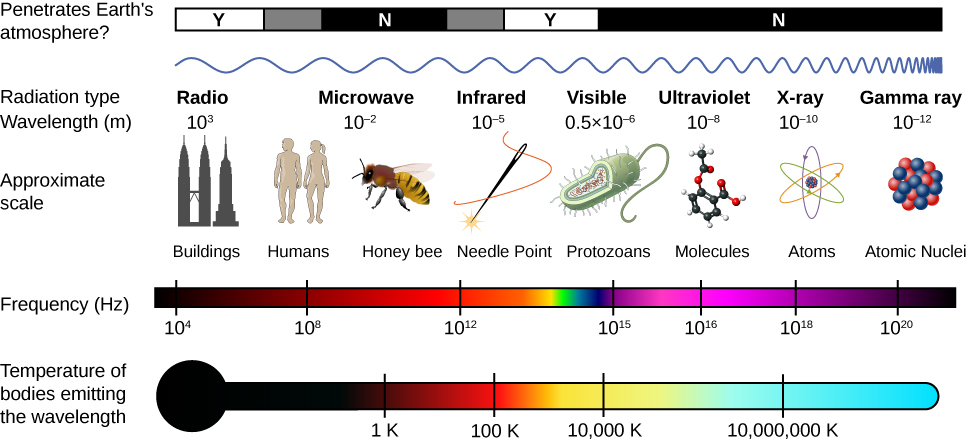| << Chapter < Page | Chapter >> Page > |
Electromagnetic waves have a vast range of practical everyday applications that includes such diverse uses as communication by cell phone and radio broadcasting, WiFi, cooking, vision, medical imaging, and treating cancer. In this module, we discuss how electromagnetic waves are classified into categories such as radio, infrared, ultraviolet, and so on. We also summarize some of the main applications for each range.
The different categories of electromagnetic waves differ in their wavelength range, or equivalently, in their corresponding frequency ranges. Their properties change smoothly from one frequency range to the next, with different applications in each range. A brief overview of the production and utilization of electromagnetic waves is found in [link] .
| Type of wave | Production | Applications | Issues |
|---|---|---|---|
| Radio | Accelerating charges | Communications
Remote controls MRI |
Requires control for band use |
| Microwaves | Accelerating charges and thermal agitation | Communications
Ovens Radar Cell phone use |
|
| Infrared | Thermal agitation and electronic transitions | Thermal imaging
Heating |
Absorbed by atmosphere
Greenhouse effect |
| Visible light | Thermal agitation and electronic transitions | Photosynthesis
Human vision |
|
| Ultraviolet | Thermal agitation and electronic transitions | Sterilization
Vitamin D production |
Ozone depletion
Cancer causing |
| X-rays | Inner electronic transitions and fast collisions | Security
Medical diagnosis Cancer therapy |
Cancer causing |
| Gamma rays | Nuclear decay | Nuclear medicine
Security Medical diagnosis Cancer therapy |
Cancer causing
Radiation damage |
The relationship between frequency f and wavelength applies to all waves and ensures that greater frequency means smaller wavelength. [link] shows how the various types of electromagnetic waves are categorized according to their wavelengths and frequencies—that is, it shows the electromagnetic spectrum.

The term radio waves refers to electromagnetic radiation with wavelengths greater than about 0.1 m. Radio waves are commonly used for audio communications (i.e., for radios), but the term is used for electromagnetic waves in this range regardless of their application. Radio waves typically result from an alternating current in the wires of a broadcast antenna. They cover a very broad wavelength range and are divided into many subranges, including microwaves, electromagnetic waves used for AM and FM radio, cellular telephones, and TV signals.
There is no lowest frequency of radio waves, but ELF waves, or “extremely low frequency” are among the lowest frequencies commonly encountered, from 3 Hz to 3 kHz. The accelerating charge in the ac currents of electrical power lines produce electromagnetic waves in this range. ELF waves are able to penetrate sea water, which strongly absorbs electromagnetic waves of higher frequency, and therefore are useful for submarine communications.

Notification Switch
Would you like to follow the 'University physics volume 2' conversation and receive update notifications?